3 Essential Yoga Breathing Exercises

Modern yoga is a “postural imposture”.
Let me reveal to you the true nature of millennial yoga.
Yoga is a discipline which above all allows you to regain control of the mind.
It allows you to find space within yourself to express your essential identity. Yoga is not limited to postural practice, in reality according to yoga texts, postural practice only represents 2% .
When you experience a strong emotion like crying for example. Your breathing is racing, isn't it? In reality, your emotions are closely linked to your breathing.
THE yoga seeks a certain emotional stability, what could be better than starting with breathing exercises!
Concentration on breathing through exercises is more subtle than focusing on your body. The breathing exercise in yoga is called the Pranayama. The final objective is to reach a meditative state, where we leave the weight of everyday concerns behind.
According to yoga, this state allows us to find a higher intelligence, an intuitive intelligence. THE breathing exercises practiced in yoga allow us to achieve this vital intelligence.
Breathing is the tempo in yoga, it is the foundations. Before you focus on anything else, you need to master this type of inhaling and exhaling.
Ready to try?
First Yoga Breathing Exercise: Ujjayi Breathing
There breathing in yoga should be long and regular. It is important to slow down the passage of air to achieve slower breathing. To achieve this objective, a small contraction should be implemented at the back of the throat. This contraction slows down breathing and makes it deeper and more effective for the practice of yoga. It also helps improve concentration and calm the mind.
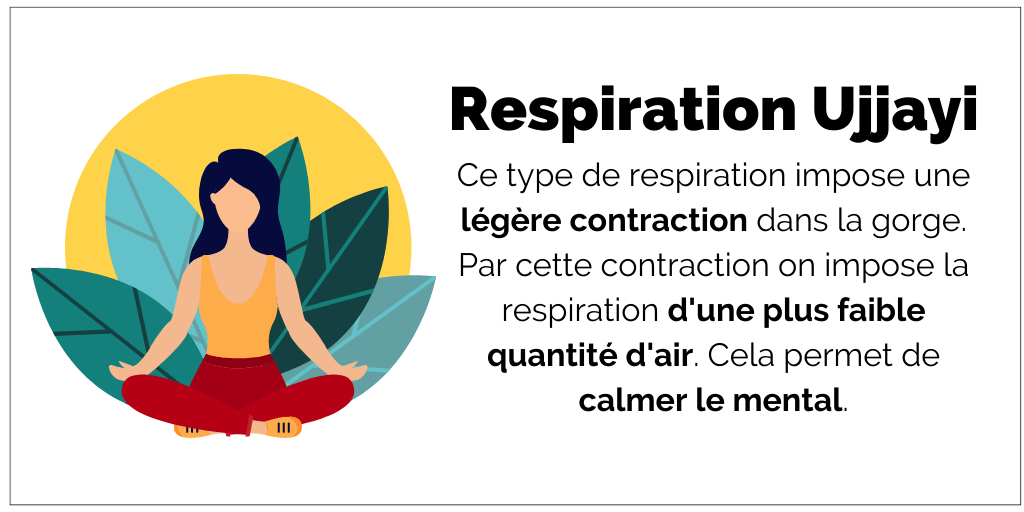
To represent this to you, I would like to introduce an image that will speak to you:
When you clean your glasses, you want to create mist on them. You breathe from the back of your throat. Do you see what I'm talking about ? This exhalation seeks to create warm air so that moisture is deposited on your glasses.
Here are the steps to master Ujjayi breathing:
- Make yourself comfortable on your mat or simply sitting on a chair
- Perform this expiration corresponding to the humidification of your glasses (see explanations above)
- Try to amplify it, by exhaling longer. You will see that this is not a breathing exercise. No need to have a lot of “safety”.
- Realize that it is actually just a contraction in the back of your throat
- Normally, you can inhale in the same way.
- The final touch is to close your mouth and have that breathing through your nose only. Inhaling and exhaling in this way will give you the impression of having different control over the amount of air involved.
Second Yoga Breathing Exercise
The second exercise is carried out when you master Ujjayi breathing (first exercise).
It's about correctly placing your attention (the mind) when inhaling and exhaling.
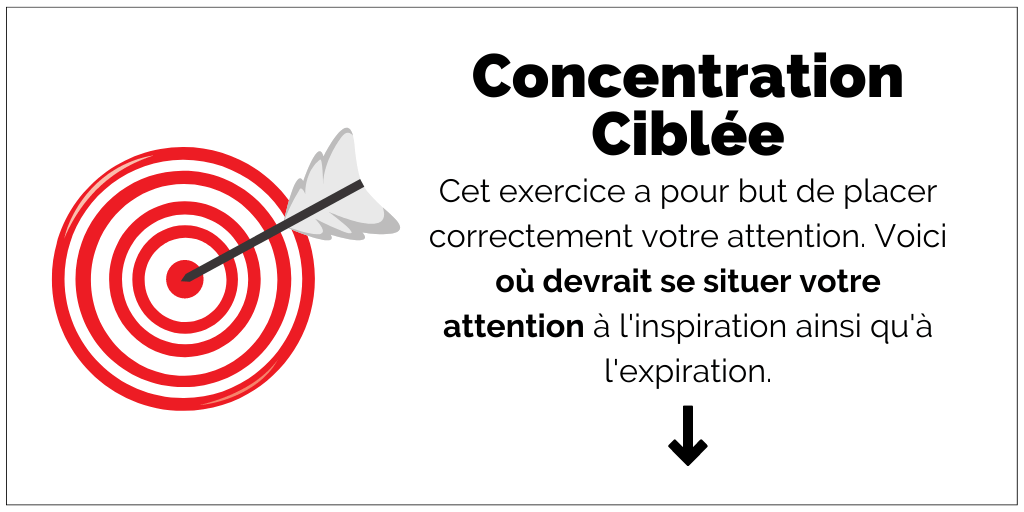
For inspiration :
You should focus your attention at the top of your ribcage. That is to say in the armpits, your shoulders, your collarbones, in the chest.
For exhalation :
You must have your attention at the level of the navel, your perineum. As you exhale, you should imagine your lower stomach touching your navel.
Third Exercise: How to breathe during yoga exercises?
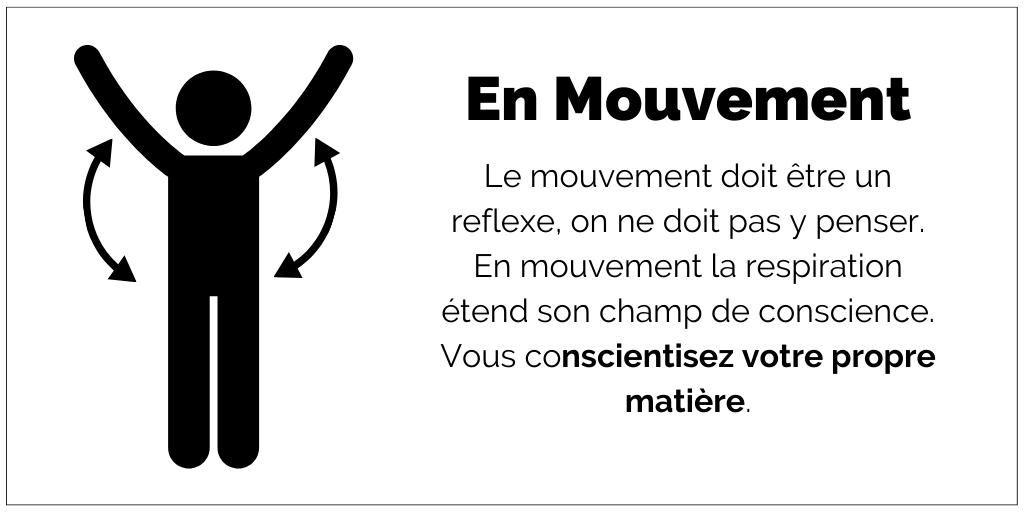
In the third exercise, the goal is to add the movements. Raise your arms on either side of your chest as you inhale, and lower them alongside your body as you exhale.
Your arms should be the bodily illustration of your breathing. As if remotely controlled by her. Your mind must remain (as described in the second exercise) in your ribcage. This movement should be natural, you shouldn't have to think about doing it.
This exercise aims to make you aware of your own material.
Your breathing must be firm, to have the right attention.
Pranayama: The idea behind the exercises to INTERRUPT our neurotic breathing
You are a follower! Follower of what? External stimulation.
Your breathing evolves according to your environment.
Control must be established.
This control comes through breathing.
This is called Pranayama.
For example, chanting is a reduced genre of Pranayama.
Submitting yourself to Pranayama can lead you to transcendent benefits!
Yoga master Yania Valkia indicates that by practicing this breathing for 1h30 every day (be careful, it's very hard) for 10 days, you would no longer be afraid of death.
It's not nothing, is it?
Training in breathing is essential because it will allow you to achieve greater presence within yourself. But at no time should you seek performance, because mastering the posture means finding your respiratory, mental and physical limit.
You do it without knowing it
Unconscious breathing is vomiting according to ancient texts. She is out of control and submits to the mental state of the moment. Look when you cry when you laugh, how is your breathing? Is she under control?
But then how can we destroy this unconscious (uncontrolled) breathing?
Through pranayama.
What was:
- Not long (your breathing)
- Not aware
…we destroy it with breathing exercises.
Subsequently, the posture is only at the service of this breathing. The purpose of bending is to control airflow.
Benefits of Yoga Breathing
The duration of inhalation and exhalation among grandmasters can be 1 minute. It's a real endurance workout.
If you can breathe this way, you learn to really control your parasympathetic system.
Your body and therefore your mind are under control.
Your breathing should be subtle and not loud to help you internalize.
At the end of a pranayama you should have calm breathing which allows you to stay on course.
It’s about fully deploying one’s identity.
It means becoming aware of one's environment and possibly cutting ties or rebelling against it.
It's scary to stay the course, because it sometimes means going through the fear of being misunderstood, of finding yourself alone or rejected.
In this sense, I encourage you to look at the moments in your life where you prohibited yourself from doing this or that thing.
Have you denied yourself things that, however, were aligned with yourself?
Conclusion
This type of practice allows for acute awareness of yourself.
Getting started with yoga breathing is done in stages.
As you can see, this takes some work.
Until you master the breathing described in the different exercises, do not consider moving on to the next step.
You should be able to repeat this breathing for 15 minutes.
Which may seem difficult.
But if the journey to greater consciousness were simple, we would all be wise Yogi.
Good luck !
Related posts
Yoga and emotional health: overcoming the identity crisis
According to yoga philosophy, the greatest challenge for human beings is to confront their own identity crisis. Do we know each others ? Our impoverished relationships with ourselves are characterized by a lack of listening, abandonment and respect for our intuition. Our real identity remains unknown to the majority of […]
Yoga Therapy: the art of supporting the natural healing process
The discipline of yoga is whole and indivisible. However, it allows five different approaches to be distinguished. These five approaches should in no way be confused with the different schools of yoga, the appearance of which is relatively recent in the history of this practice. Traditionally, yoga is a: a discipline that meets the various needs […]
3 Essential Yoga Breathing Exercises
Modern yoga is a “postural imposture”. Let me reveal to you the true nature of millennial yoga. Yoga is a discipline which above all allows you to regain control of the mind. It allows you to find space within yourself to express your essential identity. Yoga is not limited to postural practice, in reality […]

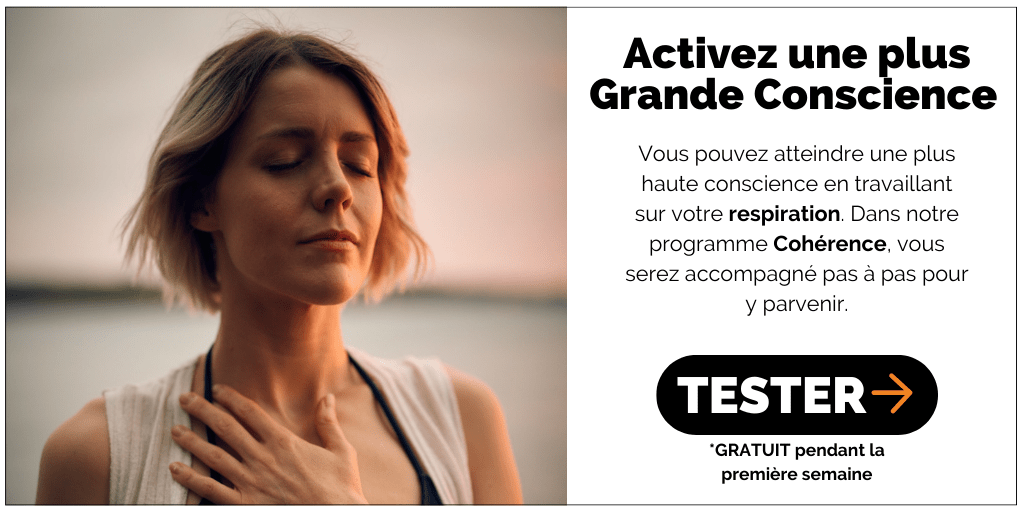
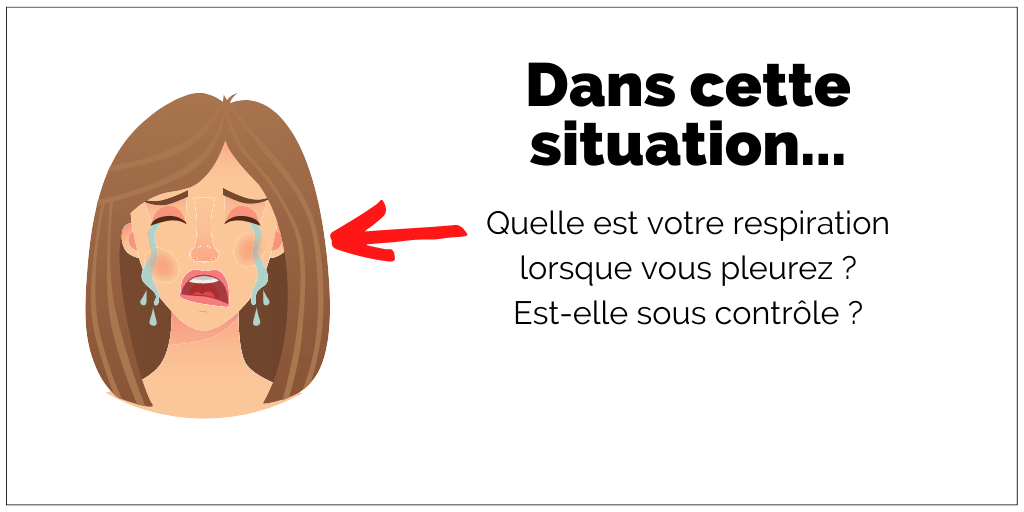
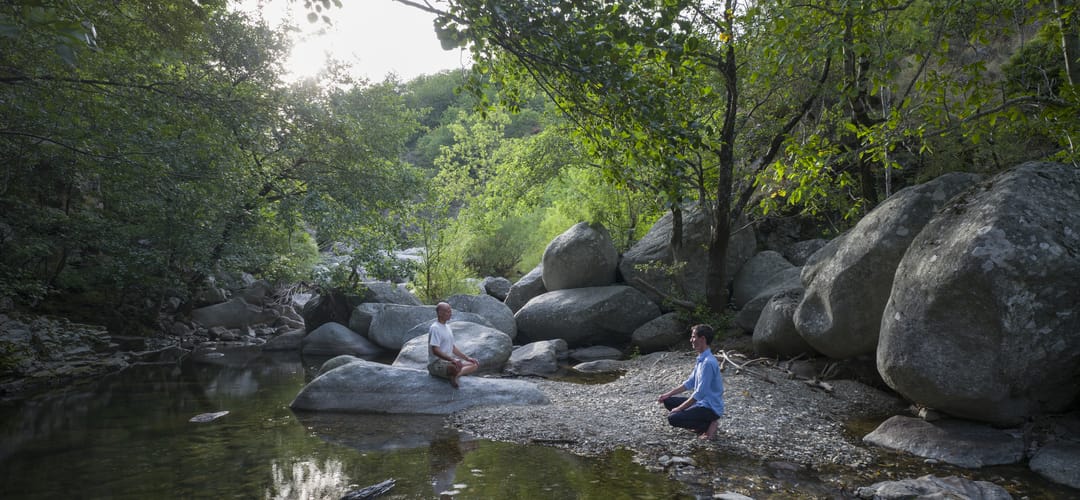


 Éric Laudière is a practitioner and trainer in the field of psychogenealogy and family constellations.
Éric Laudière is a practitioner and trainer in the field of psychogenealogy and family constellations. Julia
Julia As a visceral and digestive surgeon, Pascal is accustomed to caring for others, but when he reached his forties, he faced his own health challenges.
As a visceral and digestive surgeon, Pascal is accustomed to caring for others, but when he reached his forties, he faced his own health challenges. Géraldine Rincheval discovered Yoga 16 years ago, during her first pregnancy. This decisive moment marked the beginning of a deep relationship with Yoga, a discipline that has accompanied her throughout her life.
Géraldine Rincheval discovered Yoga 16 years ago, during her first pregnancy. This decisive moment marked the beginning of a deep relationship with Yoga, a discipline that has accompanied her throughout her life.  Osteopath and Trainer. Charbel helps therapists make their activities profitable, financially, on the effectiveness of their treatments and on their personal development.
Osteopath and Trainer. Charbel helps therapists make their activities profitable, financially, on the effectiveness of their treatments and on their personal development.  Philippe Pire has been a physiotherapist and osteopath based in Brussels for 38 years.
Philippe Pire has been a physiotherapist and osteopath based in Brussels for 38 years. After a diploma in History and the Art Market, and nearly 15 years as a sales manager in the tertiary sector, Sabine completed a CAP in cooking and worked in several restaurants, including 1 Michelin star.
After a diploma in History and the Art Market, and nearly 15 years as a sales manager in the tertiary sector, Sabine completed a CAP in cooking and worked in several restaurants, including 1 Michelin star. André, a Mezierist physiotherapist, has long had a spiritual quest to enlighten his path.
André, a Mezierist physiotherapist, has long had a spiritual quest to enlighten his path. Valérie encountered yoga in 2007 and without her teachers clearly suggesting it, she was immediately sensitive to the practice of breathing and in particular Ujjuyi. Also, when she discovered the teachings of Marc Beuvain in 2015, she was deeply touched by his pedagogy and his approach. She was thus able to clearly understand that breathing was a key to the practice.
Valérie encountered yoga in 2007 and without her teachers clearly suggesting it, she was immediately sensitive to the practice of breathing and in particular Ujjuyi. Also, when she discovered the teachings of Marc Beuvain in 2015, she was deeply touched by his pedagogy and his approach. She was thus able to clearly understand that breathing was a key to the practice. I am a father of two little girls. I am 47 years old living in Brussels and working in the digital field.
I am a father of two little girls. I am 47 years old living in Brussels and working in the digital field. A pharmacist by training, Julie is interested in health and well-being in general.
A pharmacist by training, Julie is interested in health and well-being in general. A former high-level athlete, Valérie encountered yoga in 1999 when she was looking for a physical activity devoid of competition and judgment while being passionate about subjects around personal development.
A former high-level athlete, Valérie encountered yoga in 1999 when she was looking for a physical activity devoid of competition and judgment while being passionate about subjects around personal development. Julie has always been interested in health. She obtained a doctorate in Biology in 2011 and was interested in various human pathologies such as Tuberculosis and Malaria.
Julie has always been interested in health. She obtained a doctorate in Biology in 2011 and was interested in various human pathologies such as Tuberculosis and Malaria. Frédérique has always been interested in health, wellness and natural therapies.
Frédérique has always been interested in health, wellness and natural therapies. Céline has been practicing yoga since 2008. She underwent initial teaching training between 2015 and 2019, began teaching and, at the same time, crossed paths with Marc Beuvain during a conference in Paris. Marc's vision of yoga challenges her, provokes her and touches her deeply. The first seeds are sown…
Céline has been practicing yoga since 2008. She underwent initial teaching training between 2015 and 2019, began teaching and, at the same time, crossed paths with Marc Beuvain during a conference in Paris. Marc's vision of yoga challenges her, provokes her and touches her deeply. The first seeds are sown… Marc Beuvain has been teaching Yoga for 26 years in France, but also in London, Milan, and Brussels in particular.
Marc Beuvain has been teaching Yoga for 26 years in France, but also in London, Milan, and Brussels in particular.

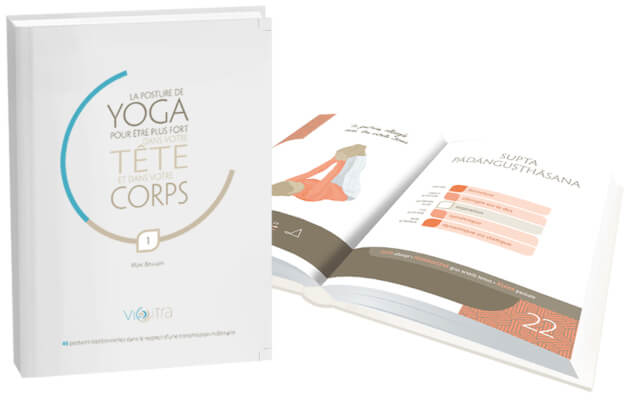
Post a comment
You must be logged in to post a comment.